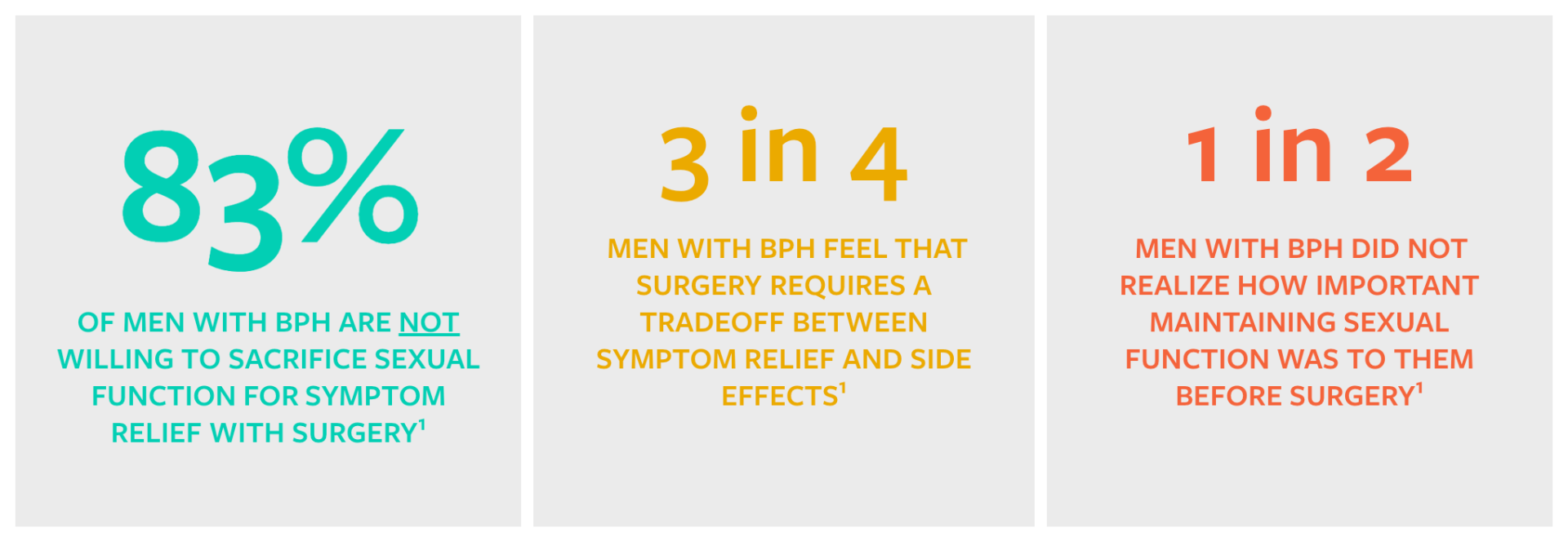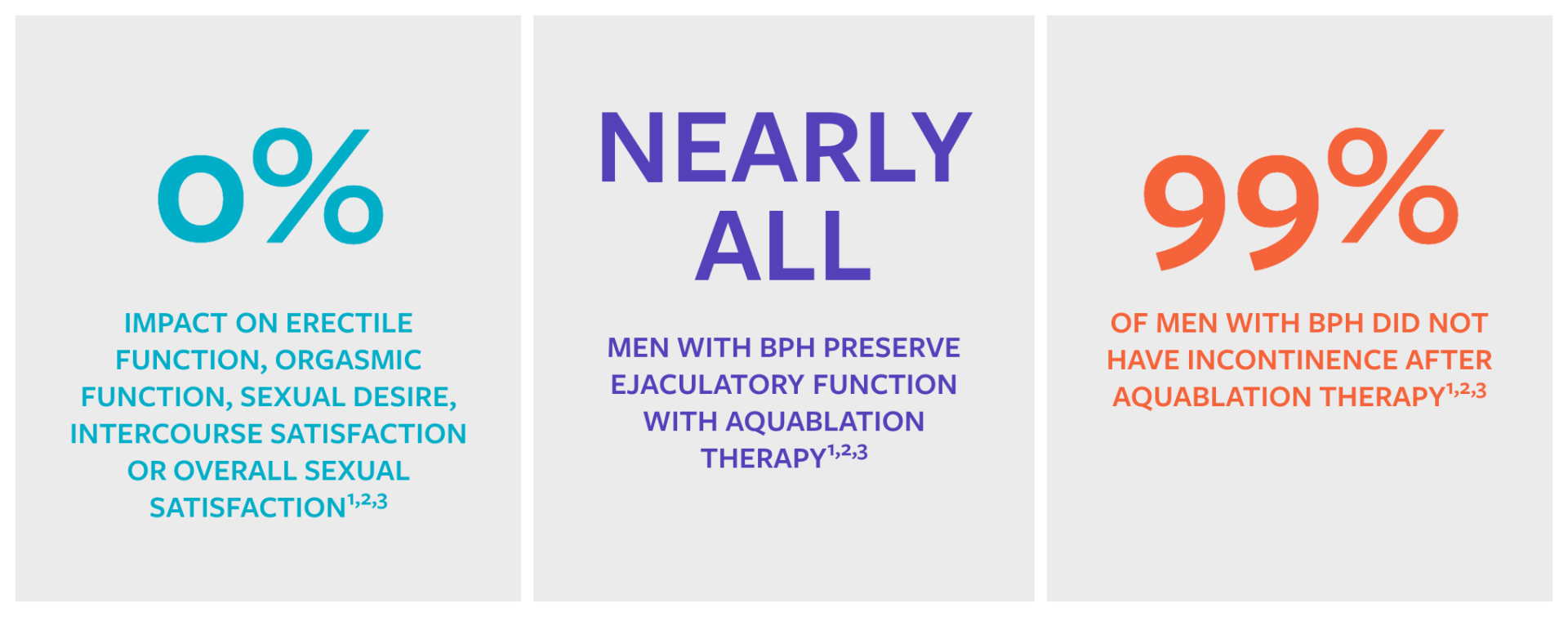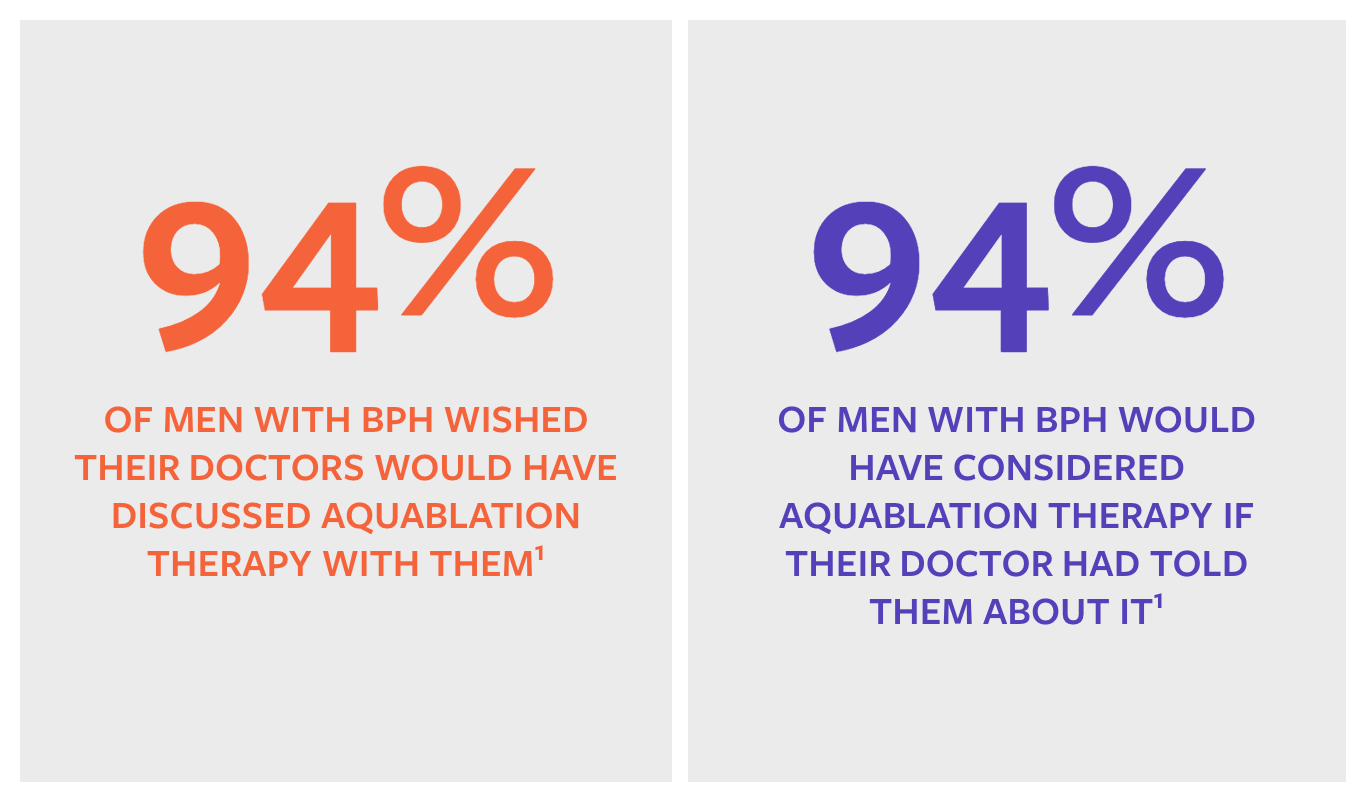Aquablation Therapy Surgical Treatment for BPH (Enlarged Prostate)
Board Certified Urologists | Robotic Surgery Specialists | Pediatric and Adult Urologic Care
Board Certified UrologistsRobotic Surgery Specialists Pediatric and Adult Urologic Care

What is Aquablation Therapy?
Aquablation therapy uses the power of water delivered with robotic precision to provide long-lasting BPH relief without compromise. It is precise, consistent, and predictable, and provides long-term relief no matter how large your prostate. 2,3
How Does Aquablation Therapy Work?
Aquablation therapy is a resective procedure, which means that the prostate tissue causing symptoms is surgically removed. No incision is made in the abdomen, as the prostate is reached through the urethra.
Aquablation therapy is performed in a hospital and is done under anesthesia. The procedure typically takes less than an hour and involves an overnight stay.
There are two key steps to the Aquablation procedure:
Step 1: Creating a Surgical Map
Every prostate is unique in size and shape. Aquablation therapy enables our surgeons to customize your procedure to your specific anatomy.
How? Aquablation therapy is the only BPH surgical procedure integrates ultrasound imaging with the standard camera (called a cystoscope). This gives our surgeons the ability to see the entire prostate in real time, which allows our surgeons to map which parts of your prostate they want to remove and which parts they want to avoid.
Specifically, this mapping enables our surgeons to avoid removing the parts of the prostate that cause irreversible complications like erectile dysfunction, ejaculatory dysfunction, and incontinence.
Step 1 - Creating a Surgical Map:
Step 2: Removing the Prostate Tissue
Once our surgeons have created a surgical map, a robotically-controlled, heat-free waterjet removes the prostate tissue that was outlined on the map. This robotic technology minimizes human error in removing prostate tissue, and ensures the prostate tissue is removed precisely, consistently, and predictably.
When required, our surgeons may choose to use a minimal amount of cautery following an Aquablation procedure to control bleeding.
Step 2 - Removing the Prostate Tissue:
What are the Side Effects of Aquablation Therapy?
We know that the primary reason men are delaying surgery is because they are concerned about side effects.1 In fact, a recent survey shows that 85% of men are concerned that surgery will cause incontinence, and 4 out of 5 men are concerned that surgery will have a permanent impact on their sexual function.1
In clinical studies, men who had Aquablation therapy had a very low rate of irreversible complications—incontinence, ejaculatory dysfunction, erectile dysfunction.2,3

Is Aquablation Therapy Right for You?
Aquablation therapy is a different kind of surgical procedure. There are three reasons it may be right for you, but make sure to discuss with our surgeons to see if you’re a candidate.
1. Low Rates of Irreversible Complications
Aquablation therapy has a very low rates of irreversible complications (incontinence, ejaculatory dysfunction, erectile dysfunction)2,3,4 because:
- It is the only procedure that gives surgeons the ability to view the entire prostate so they can create a map that avoids the parts of the prostate that cause irreversible complications.
- It is the only procedure that uses a heat-free waterjet to remove prostate tissue. Technologies that use heat to remove prostate tissue may be damaging to the parts of the prostate that control erectile function and ejaculatory function. It should be noted that some surgeons may choose to use a minimal amount of cautery following an Aquablation procedure if it is required to control bleeding.
2. Confidence in Procedure
Aquablation therapy removes prostate tissue with a robotically-controlled waterjet. This robotic technology minimizes human error and ensures the prostate tissue is removed precisely, consistently, and predictably.
3. Long-Term Relief
In clinical studies, Aquablation therapy has been shown to provide durable symptom relief.2
Take the International Prostate Symptom Score (IPSS) Quiz to measure how severe your symptoms are.
Take the Sexual Function Quiz to help you determine if maintaining sexual function after BPH surgery is important to you.

Aquablation Recovery
As with most BPH procedures, you will wake up with a catheter. Patients typically stay overnight in the hospital. We may send you home with a catheter for a few days or may keep you an additional night in the hospital if you are unable to pee on your own or empty your bladder at the time of discharge.
We know that no one likes staying overnight in a hospital. However, the benefit with Aquablation therapy is that most patients end up leaving the hospital without a catheter.2,3,4
Once you are home, you may experience mild burning during urination for a couple of weeks. This can be managed with mild pain medication.
For more information, visit aquablation.com/safety-information.
If I don't live in Nebraska am I still able to travel to Kearney Urology Center to undergo Aquablation?
Yes. Many men are seeking Aquablation as an option for their BPH. Kearney Urology Center PC is the only practice currently offering Aquablation in the 6-state region (including Colorado, Kansas, Iowa, Missouri, Montana, and Wyoming).
Kearney, NE is located on Interstate 80 and an approximate 2.5 hour drive from Omaha and 4.5 hour drive from Denver. Kearney also has daily flights (Kearney Regional Airport - SkyWest Airlines) from Denver and Chicago.
Typically, we would start with an initial in-office consultation to confirm that you are an appropriate candidate for Aquablation. Your consultation may entail testing including Cystoscopy and ultrasound of the prostate. We would then schedule your procedure at a later date which would require a second trip to Kearney. If you have already underwent the appropriate evaluation by your home Urologist - we may be able to schedule the procedure concurrently (and consultation the day prior) in the same trip and would obtain pre-authorization before you travel to Nebraska. Lastly, we typically will want to see you back in the clinic in approximately 4-6 weeks to follow up on the results of your procedure.
Have Questions or Want More Information?
For more information, call us at 308-237-7719, and visit Aquablation.com for Frequently Asked Questions.
To stay up to date on all things related to Aquablation therapy, follow Aquablation therapy on Facebook and Twitter.
REFERENCES
1. Data from a global survey of 300 patients with BPH. Data on file at PROCEPT BioRobotics.
2. Gilling, P, et al. Three-Year Outcomes after Aquablation Therapy Compared to TURP: Results from a Blinded Randomized Trial. Can J Urol. 2020 Feb;27(1):10072-10079.
3. Bhojani, N, et al. Aquablation for Benign Prostatic Hyperplasia in Large Prostates (80-150 cc): 1-Year Results. Urology. 2019 Jul;129:1-7.
4. Data on file at PROCEPT BioRobotics.
FINE PRINT
INDICATIONS FOR USE
United States, Canada, Hong Kong
The AquaBeam® Robotic System is intended for the resection and removal of prostate tissue in males suffering from lower urinary tract symptoms due to benign prostatic hyperplasia.
Rest of World
The AquaBeam Robotic System is intended for the resection and removal of prostate tissue in males suffering from lower urinary tract symptoms.
IMPORTANT SAFETY INFORMATION
All surgical treatments have inherent and associated side effects. The most common side effects are mild and transient and may include mild pain or difficulty when urinating, discomfort in the pelvis, blood in the urine, inability to empty the bladder or a frequent and/or urgent need to urinate, and bladder or urinary tract infection. Other risks include ejaculatory dysfunction and a low risk of injury to the urethra or rectum where the devices gain access to the body for treatment. For more information about potential side effects and risks associated with Aquablation therapy for Benign Prostatic Hyperplasia (BPH) treatment, speak with your urologist or surgeon. No claim is made that the AquaBeam® Robotic System will cure any medical condition, or entirely eliminate the diseased entity. Repeated treatment or alternative therapies may sometimes be required.
© 2020 PROCEPT BioRobotics Corporation. All Rights Reserved. AQUABLATION, and PROCEPT BioRobotics are registered trademarks of PROCEPT BioRobotics. ML0321.A

Share On: